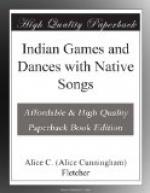When the players about the mat, the singers about the board drum and the messenger standing at the eastern end of the mat are all in readiness, the singers begin the following song, keeping time by beating with their drum-sticks on the board drum; the players about the mat join in the singing.
HIDING THE DISKS
[Music]
The player at the western end of the mat opens the bundle of excelsior or other material and spreads it on the mat and then puts all the nine disks under the material, making many movements as he does so, all of which must be in rhythm with the song, rolling the disks about under the material and finally dividing them into two parts, well covered up by the material. He continues to make passes with his hands as though invoking mysterious forces and to shuffle around the two piles of material in which the disks are hidden. Suddenly a player points to one of the piles; the player at the end ceases to shuffle and sends the disks concealed in the pile rolling down the mat to the messenger standing at the other end, who looks to see if the “chief” is among the disks rolled toward him. If he finds it, all of the players on the side of the guesser give the victory shout and the messenger goes to the small mat, brings one of the tally-sticks and stands it before the successful guesser. Then the messenger rolls the disks back to the other end of the mat where the person sits who hides the disks. That player begins again his passes and movements as he mixes together the nine disks and hides them under the material; then he divides the disks and the material under which they are hidden into two piles, shuffles them about until a player points to a pile, when he at once stops shuffling and sends the disks under the pile pointed at rolling down the mat to the messenger. If the “chief” is not found among the disks, the side to which the unsuccessful guesser belongs loses a point, and the messenger takes from the small mat a tally-stick and stands it at the end of the row of players on the opposite side. The disks are then sent spinning over the mat to the player who hides them. He mixes up the disks, hides them, shuffles the piles until another guess is made. If that guess should be by a player on the side that had just lost a point, and the guess prove to be successful—that is, the pile pointed at contain the “chief”—then the messenger takes the tally-stick that had been put at the end of the row of the opposite side and stands it in front of the successful guesser. He could not take back a tally-stick that had been won by a guess unless all the tally-sticks had been taken from the small mat. One side or the other must win twenty points to be victor in the game. In the process of winning the game the tally-sticks may therefore be taken back and forth before one side wins the entire twenty.
The victory shout is given only when a successful guess is made. The singing stops at a victory shout and is resumed as soon as the disks are rolled back to the player who hides the disks. He must be careful to keep all his dramatic actions and movements of hands, arms, body and head in rhythmic accord with the song. The steps and movements of the messenger must also be in time with the song.




